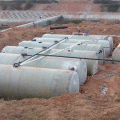GAS STATION CATHODIC PROTECTION FOR UNDERGROUND STORAGE TANKS (UST'S)
11jan 2017

Cathodic Protection of Underground Storage Tanks (UST's) system is an efficient system used for protecting the underground metal objects from corrosion.
CATHODIC PROTECTION FOR UNDERGROUND STORAGE TANKS (UST'S)
Cathodic Protection system is an efficient system used for protecting the underground metal objects from corrosion. In this paper the use of Cathodic Protection (CP) system and how they can be developed to simulate corrosion control solution was illustrated. The aim of developing a Cathodic Protection system is to provide control over oil pipelines and to reduce the incidence of corrosion. The proposed system integrates the technology of wireless sensor Network (WSN) in order to collect potential data and to realize remote data transmission. In this system each WSN receives the data from the environment and forwards it to a Remote Terminal Unit (RTU). Then each RTU forwards it to its base station (BS). In this work Labview 2010 program was used, due to its high potentials. In addition it contains a Tool Kit that supports the wireless sensor network. In this simulation used many cases study to test and monitoring data and get optimum results, least time delay and high speed to prevent corrosion.
KEYWORDS
Cathodic protection, corrosion control, anode systems, pipeline cathodic protection, gas lines, cathodic design service, impressed current, galvanic anodes, test stations, UST protection, underground storage tanks, NACE Certified, STI Certified, DEQ Certified, DERR Certified
| [1] | P. R. Roberge, “Handbook of Corrosion Engineering,” 1st Edition, McGraw-Hill PY, I, New York, 2000. |
| [2] | N. Summers, “Remote Monitoring of Pipeline Cathodic Protection Systems,” Petromin Pipeline, April-June 2009. |
| [3] | M. Hafiz, “Modeling of Pipeline Corrosion Control by Cathodic Protection,” Ph.D. Thesis, AL-Technology University, Baghdad, 2006. |
| [4] | S. Gundogdu and O. Sahin, “E.M.I Effects of Cathodic Protection on Electromagnetic Flowmeters,” Sensors, Vol. 7, No. 1, 2007, pp. 75-83. |
| [5] | M. Al-Somaidai and O. Alsaydia, “Remote Monitoring and Controlling of Gas Sensors Using VPN Connection,” The First International Conference on Future Communication Networks ICFCN, Baghdad, 2-5 April 2012, pp. 84-87. |
| [6] | J. Bushman, “Corrosion and Cathodic Protection Theory,” Bushman & Associates Inc., Medina, 2010. |
| [7] | A. Kumar and L. D. Stephenson, “Comparison of Wireless Technologies for Remote Monitoring of Cathodic Protection Systems,” U.S. Army Corps of Engineers, Engineer Research and Development Center Construction Engineering Research Laboratory, Champaign, 2007. |
| [8] | L. Ting and Z. Xiang, “Optimization Of Remote Monitoring of Cathodic Protection Power Supply System Base on Four-Tier Structure and B/S Model,” The 6th International Conference Computer Science & Education (IC-CSE), Singapore, 3-5 August 2011, pp. 1346-1350. |
| [9] | M. Parsa, S. Allahkaram and A. Ghobadi, “Simulation of Cathodic Protection Potential Distributions on Oil Well Casings,” Journal of Petroleum Science and Engineering, Vol. 72, No. 3-4, 2010, pp. 215-219. doi:10.1016/j.petrol.2010.03.020 |
| [10] | J. Bushman, “Galvanic Anode Cathodic Protection System Design,” Bushman & Associates Inc., Medina, 2010. |
| [11] | A. Abed, “Design and Implementation of a Wireless Sensor/Actuator Network for the Development of an Industrial Wireless DCS System,” Ph.D. Thesis, AL-Basra University, Basra, 2012. |
| [12] | J. T. Al-Haidary, M. H. Hafiz and Y. M. Abdu Al-Sahib, “Galvanic Cathodic Protection Evaluation of a Steel Pipe in Iraqi Soil,” Journal of Medical Engineering & Technology, Vol. 29, No. 9, 2011, p. 1673. |